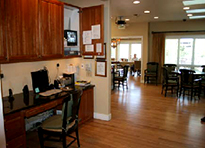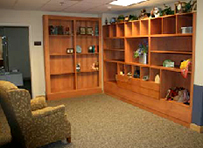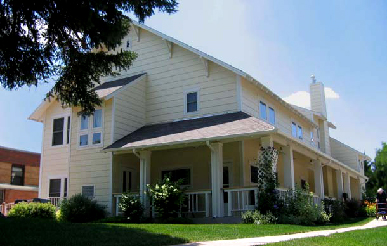A therapeutic environment is an environment that is supportive of individuals with dementia and their families. It recognizes that people with dementia are influenced by their surroundings and do better with environments that are individualized, flexible, and designed to support differing functional levels and approaches to care (Campernel & Brummett, 2010).
Maintaining a positive and healthy physical environment is important because people with dementia rely on environmental cues to support them physically, cognitively, and emotionally. Unfamiliar, chaotic, or disorganized environments are stressful and can cause anxiety, disorientation, and contribute to behavioral problems.
Assessing the Agency’s Philosophy of Care
When assessing a care home, family members should feel free to question the facility’s philosophy of care. They should consider the following issues before choosing a long-term care facility:
- Is the facility’s philosophy for caring consistent with your beliefs?
- Does the facility provide services to persons at all stages of dementia?
- What conditions or behaviors determine whether a facility will admit or retain someone with dementia?
- Is dementia care provided in a separate unit or as an integrated part of facility services?
- Is the facility’s philosophy and practice of handling “difficult behaviors” compatible with your views?
- What is the facility’s philosophy about using physical restraints to deal with certain behaviors?
- Does the facility recommend the use of psychoactive drugs to treat behaviors? (CANHR, 2018)
At a minimum, an organization caring for people with dementia should share a philosophical approach that understands that people with dementia deserve and need kind and supportive treatment focused on dignity, respect, and autonomy. This approach, called person-centered care, depends not only on the caregivers’ skills and knowledge but also on tailoring care to both residents’ and caregivers’ needs and preferences. This means that there must be flexibility in an organization (Desrosiers et al., 2014). Person-centered care is also referred to as dementia-friendly care, which promotes inclusion of the person living with dementia and their caregivers in care and treatment decisions, with the aim of increasing positive outcomes for both (Handley et al., 2015).
The Physical Environment
There is a connection between the environment and how people feel and behave. Homes or buildings thoughtfully designed for the care of people with dementia encourage community, maximize safety, support caregivers, cue specific behaviors and abilities, and redirect unwanted behaviors (Campernel & Brummett, 2010). This holistic vision of dementia care considers the consequences of the built environment on the well-being of residents with dementia (Rijnaard, et al. 2016).
Indoor design changes that have been shown to reduce unwanted behaviors and enhance a sense of well-being in people with dementia include:
- Provide private space in the resident’s room with a private bathroom and a separate bedroom or recess for sleeping.
- Provide public spaces with easy accessibility and places for semi-private interactions.
- Personalize rooms with furniture, memorabilia, pictures, and personal possessions.
- Provide televisions and computers within a person’s room.
- Ensure cleanliness in private rooms and public spaces and get rid of odors.
- Provide sunlight, ventilation, and remove dark nooks and crannies.
- Replace institutional, centralized nursing stations with smaller, residential-looking stations.
- Create spaces to cue specific behaviors (activity kitchen, art and music therapy area, bistro/bar, rummaging room, library, coffee shop/internet café, quiet room, living room, family visiting area).


Left: Residential-looking, smaller-scaled nurses’ station. Right: a room for rummaging. Source: Campernel & Brummett, 2010. Used with permission.
Outdoor design changes for people with dementia and memory disorders include:
- Arrange spaces to resemble a natural community.
- Create continuous circulation routes with looping pathways and areas of interest.
- Include residents in the design of new features such as walking paths and gardens.
- Create safe, purposeful, and accessible outdoor areas.
- Offer attractive landscaping, gardens, and a view to the outside. (Rijnaard et al. 2016)


Left: Safe, looping wandering paths with areas of interest along the way. Right: A memory-care facility with home-like outdoor porch area for seating and reflection. Source: Campernel & Brummett, 2010. Used with permission.
In a comparison of “regular” specialized care units and small, homelike specialized care units in the Netherlands, residents in the homelike care units needed less support with activities of daily life, were more socially engaged, showed less agitation over time, and needed less psychotropic medication and physical restraints. Residents of the small, homelike units awarded higher scores to aspects of quality of life, showed less negative affect, better social relationships, and were more engaged in activities (Kok et al., 2016).
Although there is a trend towards the development of smaller, home-like nursing homes, large nursing homes are still the norm. In the U.S., the number of beds per nursing home has remained largely unchanged in recent years at an average 108.7 beds per facility. Between 2009 and 2014, Massachusetts rose slightly from 114 beds per facility to 116, while occupancy declined slightly from 88.13% to 86.8% during the same period (Harrington & Carrillo, 2015). In 2017, the average number of beds remained at 116 and while occupancy had declined steadily to 84% (KFF, 2017).
Safety and Security
People with dementia need feel safe (and be safe) without the use of physical and chemical restraints. Safety includes creating an appropriate environment as well as planning for adverse or unplanned events.
The table below illustrates some common safety hazards along with suggestions to help make the environment more safe and secure. Since every situation is different, interventions must be tailored to match the specific circumstances.
Measures to Promote Safety and Security | ||
|---|---|---|
Safety issue | Possible consequence | Intervention |
Wandering | Getting lost, exposure to environmental hazards |
|
Cooking without supervision | Fire, injury |
|
Falls | Injury |
|
Poisoning | Sickness or death |
|
Simply living in a longterm care facility or receiving care at an adult day care center can be a source of safety and security for a person with dementia. Having regular contact with a caregiver provides a sense of privacy, safety, and security. A well-designed and well-run facility is secure, comfortable, and predictable; a place where one can feel at ease—a place where you can be who you are and feel connected with like-minded people (Rijnaard et al., 2016).
Schedules and Routines
Schedules and routines are an important part of any person’s life and well-being. However, when someone enters a long-term care facility they are unable to continue with their usual routines; their lives are undeniably altered. There is a continual tension between the necessary institutional routines and the residents’ personal habits and needs (Rijnaard et al., 2016).
In traditional nursing homes, daily life is primarily organized around the routines of the nursing home and the convenience of the staff; schedules can change dramatically from day to day. This is difficult for people with dementia because they rely on a predictable routine for orientation. A regular routine allows a person with dementia to know what to expect and also gives caregivers a benchmark for evaluating a person’s behavior.
The degree to which residents can maintain personal routines is related to the degree to which they are able to exert control over their day-to-day life. Institutional routines, rules, and lack of control as well as continual intrusions to privacy often negatively impact residents’ well-being (Rijnaard et al., 2016).
Although caregivers are responsible for maintaining a routine schedule, they must be flexible and know when to make an adjustment. For example, when someone does not want to take a shower on a usual bathing day, it is best to simply help the person wash up and schedule the shower for another day. People with dementia tend to be slow, so caregivers need to allow ample time when preparing for an outing or an appointment. Attempting to rush can precipitate aggressive behaviors and frustrate both parties.
Staff as Part of the Environment
In 2017 there were 15,483 certified nursing homes in the United States (399 in Massachusetts) with about 1.6 million certified beds (KFF, 2017; Harrington & Carrillo, 2018). All are required to meet minimum staffing standards to attain or maintain the highest possible physical, mental, and psychosocial well-being of residents. Most facilities struggle to hire, train, and retain staff in the face of low wages, poor benefits, and risk of injury.
In facilities that serve patients with dementia, the overall work environment is challenging and training/education is not always adequate. Training programs have been shown to have modest benefits (Alzheimer’s Association, 2019). Staff turnover is one of the most vexing problems for nursing homes and other organizations that provide care for people with dementia. The turnover rate for registered nurses, licensed vocational nurses, and certified nursing assistants is significantly higher in nursing homes than in other healthcare settings.
Proper Staffing
Proper staffing is critical in nursing homes and is consistently associated with higher quality of care. Nursing homes with more RN hours per patient have been associated with positive outcomes. The benefits of higher staffing levels, especially RNs, include lower mortality rates; improved physical functioning; less antibiotic use; fewer pressure ulcers, catheterized residents, and urinary tract infections; lower hospitalization rates; and less weight loss and dehydration (Harrington & Carrillo, 2018).
States that have instituted higher minimum staffing levels have seen improvement in nurse staffing levels and in quality outcomes. A number of recommendations for minimum staffing levels have been put forth but there is no consensus or national requirement. One expert panel recommends 4.55 hours per resident day, including RNs, LVNs, and nursing assistants. In 2016 the average in Massachusetts fell in the 3.76 to 4.02 range, placing it in the lower 50% of states (Harrington & Carrillo, 2018).
Staff Adjusting to Resident Routines
When a medical-based facility is reorganized into a home-like care facility staff must adjust their routines to the routines of the residents. This requires a fundamental shift in how medical professionals have been educated and trained.
In a home-like setting, staff, residents, and family caregivers form a household together. Residents are cared for by a small fixed team of professional caregivers who are part of the household. Daily life is organized completely, or in large part, by residents and caregivers. Staff members, residents, and family members prepare meals together and staff members are involved in multiple tasks such as medical and personal care, domestic chores, and activities (Verbeek et al., 2009).
To encourage integration of the staff into a home-like environment:
- Hire staff with the emotional skills to interact with people with memory problems.
- Eliminate institutional, centralized nursing stations.
- Locate nursing and work areas throughout the building for staff convenience.
- Allow staff to control lighting and environmental levels.
- Emphasize signage for residents, limit signage for staff and visitors.
- De-emphasize or camouflage doors to staff and utility areas.
- Keep staff consistent.
